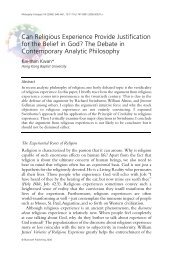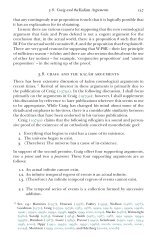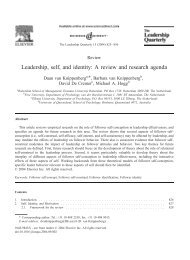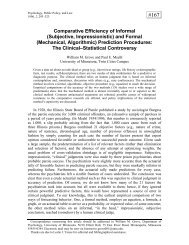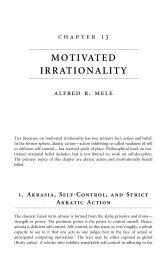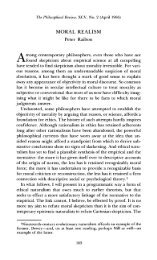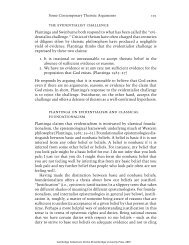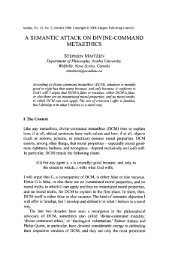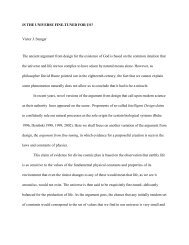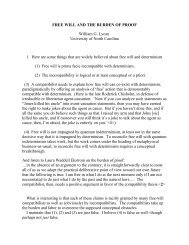Atheism and Theism JJ Haldane - Common Sense Atheism
Atheism and Theism JJ Haldane - Common Sense Atheism
Atheism and Theism JJ Haldane - Common Sense Atheism
Create successful ePaper yourself
Turn your PDF publications into a flip-book with our unique Google optimized e-Paper software.
<strong>Atheism</strong> <strong>and</strong> <strong>Theism</strong> 53<br />
that the original diagnosis was incorrect. Again, many diseases have spontaneous<br />
remissions which are not regarded by medical experts as miraculous.<br />
Furthermore our underst<strong>and</strong>ing of psychosomatic medicine may allow us to<br />
explain some apparently miraculous cures of illness. Sometimes we doubt the<br />
fact itself. The man raised from the dead may not really have been dead. On<br />
the other h<strong>and</strong>, to allude to an example discussed by Hume, if a one-legged<br />
man is reported to have been made two-legged, we judge that there must<br />
have been some error in the testimony. There can hardly be misdiagnosis of<br />
the number of a man’s legs, <strong>and</strong> there could be no medical or biological<br />
explanation of the sudden sprouting of a previously amputated human leg.<br />
Hume puts the point in too empiricist a way. He holds our doubt of the<br />
report of such a sprouting of a leg to be ‘because it is contrary to our experience’.<br />
The credulity <strong>and</strong> knavery of humankind (<strong>and</strong> perhaps love of the<br />
marvellous for its own sake) provide a ready enough explanation. However,<br />
by just saying ‘contrary to experience’ Hume does not do justice to the<br />
importance of theory in our scientific background knowledge. Consider the explosion<br />
of an asteroid eight kilometres above a fortunately uninhabited<br />
part of Siberia early in this century, flattening trees over 2,200 square kilometres.<br />
Fortunately the observation of such an occurrence is not a common<br />
experience, but our knowledge of the astronomy of the solar system is such<br />
that an occurrence of this sort is quite intelligible <strong>and</strong> to be expected to<br />
occur occasionally.<br />
We must remember that in his discussion of miracles Hume was not in<br />
his mood of extreme epistemological scepticism, according to which anything<br />
could be followed by anything. That is, Hume is not concerned with mere<br />
logical inconsistency. Hume was of course aware that there is no logical<br />
inconsistency in supposing that a one-legged man suddenly sprouted a new<br />
second leg. We must suppose that Hume is concerned with physical possibility<br />
or impossibility. Now our notion of physical possibility has to do with the<br />
question of whether a phenomenon fits coherently into a web of belief. Of<br />
course there are anomalies in science, but these are not regarded as miracles.<br />
A good example from the past is that of the advance of the perihelion of<br />
Mercury, which could not be fitted in with Newtonian mechanics <strong>and</strong> gravitational<br />
theory, but which later was accommodated by the general theory of<br />
relativity. Normally a scientist will not ab<strong>and</strong>on a theory until there is a better<br />
theory to replace it. (Compare Bruce Bairnsfather’s First World War cartoon,<br />
of ‘Old Bill’ with another soldier sitting in a shell hole with all sorts of stuff<br />
bursting around, <strong>and</strong> saying ‘Well, if you knows of a better ’ole, go to it’.)<br />
Alternatively the scientist may be sceptical of reports of a refractory phenomenon.<br />
People who are too empiricist, accepting observation reports too readily,<br />
join forces in the credulity stakes with those who are not empiricist enough,<br />
<strong>and</strong> are ready to believe any theory however inadequately it has been tested.



